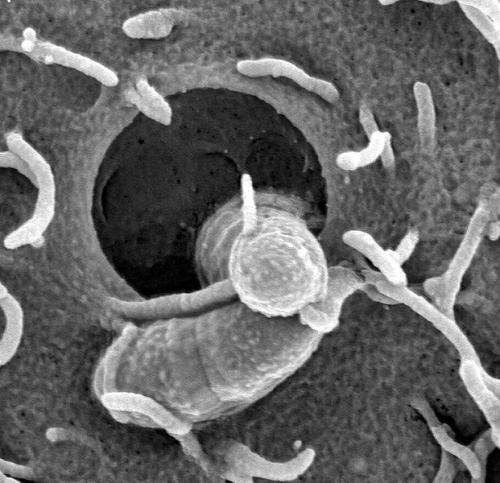The many faces of the bacterial defense system

Even bacteria have a kind of "immune system" they use to defend themselves against unwanted intruders – in their case, viruses. Scientists at the Helmholtz Center for Infection Research (HZI) in Braunschweig, Germany, were now able to show that this defense system is much more diverse than previously thought and that it comes in multiple versions. Their goal is to use the various newly discovered versions of the CRISPR-Cas gene for the targeted manipulation of genetic information, particularly for medical purposes.
The human immune system's main function is to protect us against invading bacteria, viruses, and other pathogens. To perform its job, the system has evolved into a highly complex ensemble of cells, messengers, and antibody molecules that is capable of recognizing different pathogens, defending us against them, and storing information about them.
Even the bacteria themselves are threatened by pathogens: Certain viruses, the bacteriophages (literally, "bacteria eaters"), have become specialized to invade bacterial cells and proliferate inside of them. In order to get rid of these unwanted guests, many species of bacteria make use of an arsenal of molecules that works according to similar principles as an immune system does.
The Cas enzyme recognizes DNA molecules that contain non-self genetic information, e.g. from bacteriophages, and cleaves them at specific sites. In order to recognize these molecules, a molecular copy of specific, characteristic sections of the foreign DNA is required. This copy, a kind of "molecular profile" of bacteriophage DNA and other foreign genetic material, exists as RNA, an important cellular building block, which is used, among other things, as a temporary storage site of genetic information.
The template for this profile is stored in the bacterium's own genes, specifically in those regions scientists call CRISPR (which stands for "clustered regularly interspaced small palindromic repeats" or, more simply put, the "regular arrangement of small, symmetric repeats" in the sequence of the DNA building blocks). Together, the enzyme and the profile RNA constitute the CRISPR-Cas system.
Now, Prof. Emmanuelle Charpentier's work group has scoured the genome of several hundred bacterial species in the search of CRISPR-Cas genes – and has made several discoveries. "We were able to identify new CRISPR-Cas genes in a number of bacterial species," says Charpentier, an HZI researcher who also teaches at Hannover Medical School (MHH). Among these species are much-feared germs like Streptococcus pyogenes and the meningitis pathogen, Neisseria meningitidis. "We have identified a number of these genes with the help of computers by examining known DNA sequences of the bacteria in question." Charpentier's conclusion: "The CRISPR system is not only widespread among bacteria, it also exists as an incredible range of different versions."
Knowing about these different versions is not only of academic interest but can also be tremendously useful for gene technology: "The CRISPR-Cas system is capable of cleaving DNA at very specific sites," explains Charpentier. "The Cas enzyme can already be modified in such a way that it becomes active not only in bacteria but also in animal and human cell cultures." If this kind of enzyme is specifically equipped with new RNA "profiles," it cleaves the cell's genome at precisely defined sites. "If you then use specific cellular repair mechanisms to mend the DNA strands and connect their loose ends, you can then specifically introduce new sections of genes into cellular DNA."
This opens considerable options for new forms of therapy. "I am certain that the CRISPR-Cas technology has tremendous potential," says Charpentier. "Especially for medical applications like gene therapy."
More information: Krzysztof Chylinski, Anaïs Le Rhun, Emmanuelle Charpentier, The tracrRNA and Cas9 families of type II CRISPR-Cas immunity systems, RNA Biology, 2013.
Provided by Helmholtz Association of German Research Centres
















